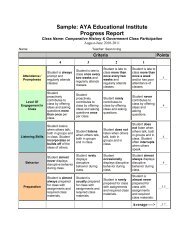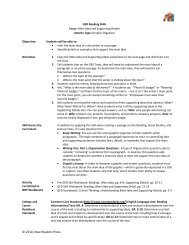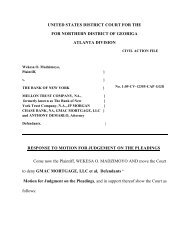601 Massachusetts Speaking Assessment Criteria (page 1 of 4)
601 Massachusetts Speaking Assessment Criteria (page 1 of 4)
601 Massachusetts Speaking Assessment Criteria (page 1 of 4)
Create successful ePaper yourself
Turn your PDF publications into a flip-book with our unique Google optimized e-Paper software.
<strong>601</strong> <strong>Massachusetts</strong> <strong>Speaking</strong> <strong>Assessment</strong> <strong>Criteria</strong> (<strong>page</strong> 1 <strong>of</strong> 4)Source: <strong>Massachusetts</strong> Department <strong>of</strong> Education <strong>Assessment</strong> <strong>of</strong> Basic Skills, <strong>Speaking</strong> <strong>Assessment</strong> RatingGuideSubjects: <strong>Speaking</strong> # <strong>of</strong> scales 4Grade(s) Not specified # Scale length 4Scale I ContentNote:The content rating focuses on the specific things which are said. It is concerned with theamount <strong>of</strong> content related to the task, the relevance <strong>of</strong> the content to the task and theadaptation <strong>of</strong> the content to the listener and the situation.This rating is concerned with content in terms <strong>of</strong> quantity, relevance and adaptation. It isnot concerned with content in terms <strong>of</strong> accuracy. Concerns with accuracy <strong>of</strong> content falloutside a speaking skills assessment. Also, make sure you are not unconsciously "fillingin" content for a speaker because you happen to know something about the speaker'stopic. If you added information, this fact should be reflected in your rating. Remember,in this component you are rating the quantity, relevance and adaptation <strong>of</strong> what thestudent says, not the accuracy <strong>of</strong> what the students says.SuperiorAdequateMinimalThe content is superior in meeting the requirements <strong>of</strong> the task.Examples are:The speaker provides a variety <strong>of</strong> types <strong>of</strong> content appropriate for the task, such asgeneralizations, details, examples and various forms <strong>of</strong> evidence.The speaker adapts the content in a specific way to the listener and situation. Thespeaker takes into account the specific knowledge and experience <strong>of</strong> the listener,adds explanations as necessary and refers to the listener's experience. The speakeruses arguments which are adapted to the values and motivations <strong>of</strong> the specificlistener.The speaker provides enough content to meet the requirements <strong>of</strong> the task.The speaker focuses primarily on relevant content. The speaker sticks to the topic.The speaker adapts the content in a general way to the listener and the situation.The speaker uses words and concepts which are appropriate for the knowledge andexperience <strong>of</strong> a general audicne3. The speaker uses arguments which are adaptedto a general audience.The speaker does not provide enough content to meet the requirements <strong>of</strong> the task.The speaker includes some irrelevant content. The speaker wanders <strong>of</strong>f the topic.The speaker adapts poorly to the listener and the situation. The speaker uses wordsand concepts which are inappropriate for the knowledge and experiences <strong>of</strong> thelistener (e.g., slang, jargon, technical language).Chicago Public Schools Bureau <strong>of</strong> Student <strong>Assessment</strong>
<strong>601</strong> <strong>Massachusetts</strong> <strong>Speaking</strong> <strong>Assessment</strong> <strong>Criteria</strong> (<strong>page</strong> 2 <strong>of</strong> 4)Source: <strong>Massachusetts</strong> Department <strong>of</strong> Education <strong>Assessment</strong> <strong>of</strong> Basic Skills, <strong>Speaking</strong> <strong>Assessment</strong> RatingGuideMinimalInadequate• The speaker does not provide enough content to meet the requirements<strong>of</strong> the task.• The speaker adapts poorly to the listener and the situation. The speakeruses words and concepts which are inappropriate for the knowledge andexperiences <strong>of</strong> the listener (e.g., slang, jargon, technical language).• The speaker says practically nothing.• The speaker focuses primarily on irrelevant content.• The speaker is highly egocentric. The speaker appears to ignore thelistener and the situation.Scale II: DeliveryNote: The delivery rating focuses on the transmission <strong>of</strong> the message. It isconcerned with volume, rate, and articulation. Some examples <strong>of</strong> poorarticulation include mumbling, slurring words, stammering, stuttering andexhibiting disfluencies such as "ahs," "uhms," or "you knows."In articulation you may be concerned with accent. However, articulationshould be rated with respect to your ability to understand the message, notthe social acceptability <strong>of</strong> the accent. One particular accent is notconsidered better than another. Remember, in this component you arerating how the student speaks, not what the student says.SuperiorAdequateMinimal• The speaker uses delivery to emphasize and enhance the meaning <strong>of</strong> themessage. The speaker delivers the message in a lively, enthusiasticfashion.• The volume varies to add emphasis and interest.• Rate varies and pauses are used to add emphasis and interest.• Pronunciation and enunciation are very clear. The speaker exhibits veryfew disfluencies, such as "ahs," "uhms," or "you knows."• The volume is not too low or too loud.• The rate is not too fast or too slow. Pauses are not too long or atinappropriate spots.• The pronunciation and enunciation are clear. The speaker exhibits fewdisfluencies, such as "ahs," "uhms," or "you knows.• The volume is too low or too loud.• The rate is too fast or too slow. Pauses are too long or at inappropriatespots.• The pronunciation and enunciation are unclear. The speaker exhibitsmany disfluencies, such as "ahs," "uhms," or "you knows."• You are distracted by problems in the delivery <strong>of</strong> the message.• You have difficulty understanding the words in the message. You have towork to understand the words.(cont'd.)Chicago Public Schools Bureau <strong>of</strong> Student <strong>Assessment</strong>
<strong>601</strong> <strong>Massachusetts</strong> <strong>Speaking</strong> <strong>Assessment</strong> <strong>Criteria</strong> (<strong>page</strong> 3 <strong>of</strong> 4)Source: <strong>Massachusetts</strong> Department <strong>of</strong> Education <strong>Assessment</strong> <strong>of</strong> Basic Skills, <strong>Speaking</strong> <strong>Assessment</strong> RatingGuideInadequate• The volume is so low that you cannot understand most <strong>of</strong> the message.• The rate is so fast that you cannot understand most <strong>of</strong> the message.• The pronunciation and enunciation are so unclear that you cannotunderstand most <strong>of</strong> the message.Scale III: OrganizationNote:The organization rating focuses on how the content <strong>of</strong> the message isstructured. It is concerned with sequence and the relationships among theideas in the message.Make sure you are not unconsciously "filling in" organization for aspeaker, because you happen to know something about the speaker's topic.If you have to make assumptions about the organization, this fact should bereflected in your rating. Remember, in this component you are rating howthe student organizes the message, not what the students says.SuperiorAdequateMinimalInadequate• The message is overtly organized.• The speaker helps you understand the sequence and relationships <strong>of</strong>ideas by using organizational aids such as announcing the topic,previewing the organization, using transitions, and summarizing.• The message is organized. You do not have difficulty understandingthe sequence and relationships among the ideas in the message. You donot have to make assumptions about the sequence and relationships <strong>of</strong>ideas.• You can put the ideas in the message in an outline.• The organization <strong>of</strong> the message is mixed up; it jumps back and forth.• The organization appears random or rambling.• You have difficulty understanding the sequence and relationshipsamong the ideas in the message. You have to make some assumptionsabout the sequence and relationship <strong>of</strong> ideas.• You cannot put the ideas in the message into an outline.• The message is so disorganized you cannot understand most <strong>of</strong> themessage.(cont'd.)Chicago Public Schools Bureau <strong>of</strong> Student <strong>Assessment</strong>
<strong>601</strong> <strong>Massachusetts</strong> <strong>Speaking</strong> <strong>Assessment</strong> <strong>Criteria</strong> (<strong>page</strong> 4 <strong>of</strong> 4)Source: <strong>Massachusetts</strong> Department <strong>of</strong> Education <strong>Assessment</strong> <strong>of</strong> Basic Skills, <strong>Speaking</strong> <strong>Assessment</strong> RatingGuideScale IV: LanguageNote:The language rating deals with the language which is used to convey themessage. It is concerned with grammar and choice <strong>of</strong> words.In language you may be concerned with students who come frombackgrounds where a foreign language or a non-standard form <strong>of</strong> Englishis spoken. However, language should be rated with respect to your abilityto understand the message, not the social acceptability <strong>of</strong> thecommunication style. If a speaker's use <strong>of</strong> incorrect or non-standardEnglish grammar interferes with your ability to understand the message,this fact should be reflected in your rating. Remember, in this componentyou are rating how the student conveys the message through language, notwhat the student says.SuperiorAdequateMinimalInadequate• The speaker makes very few grammatical mistakes.• The speaker uses language in highly effective ways to emphasize orenhance the meaning <strong>of</strong> the message. As appropriate to the task, thespeaker uses a variety <strong>of</strong> language techniques such as vivid language,emotional language, humor, imagery, metaphor, simile.• The speaker makes few grammatical mistakes.• The speaker uses language which is appropriate for the task, e.g.,descriptive language when describing, clear and concise language whengiving information and explaining, persuasive language whenpersuading. The speaker uses an "elaborate code," a style <strong>of</strong>communication characterized by complex grammatical structure andabstract vocabulary.• The speaker makes many grammatical mistakes.• The speaker uses very simplistic, bland language. The speaker uses a"restricted code," a style <strong>of</strong> communication characterized by simplegrammatical structure and concrete vocabulary.• The grammar and vocabulary are so poor that you cannot understandmost <strong>of</strong> the message.Chicago Public Schools Bureau <strong>of</strong> Student <strong>Assessment</strong>
602 Oral Pr<strong>of</strong>iciency/Second Language Acquisition (<strong>page</strong> 1 0f 2)Source: Fairfax County, Virginia Public SchoolsSubjects: Listening, speaking # <strong>of</strong> scales 5Grade(s) Not specified # Scale length 4-6Scale I: Comprehension6 Understands academic discourse without difficulty.5 Understands most spoken language including academic discourse.4 Understands academic discourse with repetitions, rephrasing, and clarifications.3 Understands simple sentence in sustained conversation; requires repetitions.2 Understands words and phrases; requires repetitions.1 Understands little or no EnglishScale II: Communication6 Communicates competently in social and academic settings.5 Speaks in social and academic settings with sustained and connected discourse. Anyerrors do not interfere with meaning.4 Initiates and sustains a conversation with descriptors and details; exhibits selfconfidencein social situations. Begins to communicate in academic settings.3 Begins to initiate conversation. Retells a story or experience, asks and responds tosimple questions.2 Begins to communicate personal and survival needs.1 Begins to name concrete objects.Chicago Public Schools Bureau <strong>of</strong> Student <strong>Assessment</strong>
602 Oral Pr<strong>of</strong>iciency/Second Language Acquisition (<strong>page</strong> 2 <strong>of</strong> 2)Source: Fairfax County, Virginia Public SchoolsScale III: Fluency6 Speaks fluently.5 Speaks with near native-like fluency. Any hesitations do not interfere withcommunication.4 Speaks with occasional hesitation.3 Speaks hesitantly because <strong>of</strong> rephrasing and searching for words.2 Speaks in single word utterances and short patterns.1 Repeats words and phrases.Scale IV: Structure6 Masters a variety <strong>of</strong> grammatical structures.5 Uses a variety <strong>of</strong> structures with occasional grammatical errors.4 Uses some complex sentences. Applies rules <strong>of</strong> grammar but lacks control or irregularforms (e.g., "runned," "mans," "not never," "more higher.")3 Uses predominantly present tense verbs. Demonstrates errors <strong>of</strong> omission (leaveswords out, leaves endings <strong>of</strong>f).Scale V: Vocabulary6 Uses extensive vocabulary but may lag behind native speaking peers in vocabularydevelopment.5 Uses varied vocabulary.4 Uses adequate vocabulary. Some word usage irregularities.3 Uses limited vocabulary.Note: Scale points 1 and 2 are not defined for scales IV and V.Chicago Public Schools Bureau <strong>of</strong> Student <strong>Assessment</strong>
603 Ogden <strong>Speaking</strong> RubricSource: Ogden Elementary School, Chicago, IllinoisSubjects: Listening, speaking # <strong>of</strong> scales 5Grade(s) Not specified # Scale length 4-6Holistic Scale5 Speech is clear.Eye contact is made.Grammar is conventional.Knowledge and facts are included.Volume is appropriate.4 Speech is clear.Eye contact is made intermittently.Grammar usually correct.Knowledge and facts are partially included.Volume is appropriate.3 Presentation lacks enthusiasm.Speech is adequate.Lapses in sentence structure and grammar.Facts not included.Volume is uneven.2 Presentation shows lack <strong>of</strong> interest.Speech difficult to understand.Lack <strong>of</strong> eye contact.Knowledge is minimal.Volume is uneven.1 Lacks focus.Lacks information.Grammatical errors.No eye contact.Chicago Public Schools Bureau <strong>of</strong> Student <strong>Assessment</strong>
604 District 214 <strong>Speaking</strong> Rubric (<strong>page</strong> 1 <strong>of</strong> 4)Source: Illinois Township District 214Subjects: <strong>Speaking</strong> # <strong>of</strong> scales 12Grade(s) High school # Scale length 6Note:Each scale has six points, but not all points are defined specifically. Points1 and 6 are defined, as is the center <strong>of</strong> the scale, which falls between 3 and4.A score <strong>of</strong> 1 is assigned when the attribute being measured is absent.Scores <strong>of</strong> 2-3 are assigned when the attribute is developing. Scores <strong>of</strong> 4-5indicate adequate performance. A score <strong>of</strong> 6 is assigned when the attributeis fully developed.Scale I: Vocal Expression--ExpressivenessExpressiveness refers to the extent to which the voice usage ranges from monotonous tointeresting and enthusiastic.6 Interesting/enthusiastic3-4 Some variation1 MonotonousScale II: Vocal Expression--ClarityClarity refers to the distinctness <strong>of</strong> the articulation and pronunciation <strong>of</strong> words. This refersto the voice rather than to meaning. The rating is an evaluation <strong>of</strong> the clearness <strong>of</strong> theexpression, not the understandability <strong>of</strong> the meaning <strong>of</strong> the word being used.6 Clear throughout3-4 Generally clear1 Poor articulationScale III: Vocal Expression--AudibilityAudibility refers to appropriateness <strong>of</strong> the vocal volume used by the speaker. At oneextreme, the speaker either could not be heard at all or bellowed throughout the entirepresentation. At the other extreme, the speaker was clearly understandable throughout andused volume appropriate to the meaning <strong>of</strong> the message and the setting.6 Audible throughout3-4 Generally audible1 Cannot be heard(cont'd.)Chicago Public Schools Bureau <strong>of</strong> Student <strong>Assessment</strong>
604 District 214 <strong>Speaking</strong> Rubric (<strong>page</strong> 2 <strong>of</strong> 4)Source: Illinois Township District 214Scale IV: Physical Expression--Eye ContactEye contact refers to the degree to which the speaker maintains eye contact with thelistener(s). One extreme is represented by the person who either avoids eye contactaltogether, the other by the person who seems to be staring constantly at you. The ideal isrepresented by the person who attracts the listener's attention and interest through use <strong>of</strong>the eyes without making the listener uncomfortable.6 Involves audience with eye contact3-4 Some eye contact1 Avoids eye contactScale V: Physical Expression--Bodily MovementBodily movement refers, in this case, to movements <strong>of</strong> the entire body as well as facialexpression, and to the use <strong>of</strong> gestures. We are primarily concerned that movements focusour attention and interest appropriately rather than be stiff, erratic, or inconsistent with themessage.6 Focuses attention and interest with movement3-4 Some appropriate movement1 Stiff or erraticScale VI: Organization--OrderOrder refers to the sequencing <strong>of</strong> main points within the message. No order would beextremely confusing to listeners, while effective order helps them both to follow and toanticipate ideas.6 Effective order3-4 Some order1 No order(cont'd.)Chicago Public Schools Bureau <strong>of</strong> Student <strong>Assessment</strong>
604 District 214 <strong>Speaking</strong> Rubric (<strong>page</strong> 3 <strong>of</strong> 4)Source: Illinois Township District 214Scale VII: Organization--FocusFocus (purpose) refers to the extent to which the central thesis is clear and the subpointsare related to this thesis.6 Focus (purpose) ideas well related3-4 Clear focus (purpose)1 Unclear focus (purpose)Scale VIII: Organization--TransitionsTransitions refers to the extent to which the speaker provides internal summaries andsignal words ("in the first place," "finally," etc.) for the listener.6 Effective transitions/summaries3-4 Some transitions1 No transitionsScale IX: Support and Elaboration--ReasoningReasoning refers to the clarity and use <strong>of</strong> the reasoning process. How well does thespeaker show relationships among ideas?6 Full/effective elaboration with documentation3-4 Some elaboration1 No support(cont'd.)Chicago Public Schools Bureau <strong>of</strong> Student <strong>Assessment</strong>
604 District 214 <strong>Speaking</strong> Rubric (<strong>page</strong> 4 <strong>of</strong> 4)Source: Illinois Township District 214Scale X: Support and Elaboration--Illustrating, Exemplifying,Clarifying and DocumentingIllustrating, exemplifying, clarifying, and documenting all refer to the way the speakerworks with each idea. Does the speaker provide pro<strong>of</strong>, data, and evidence? Areillustrations, examples, etc., sufficient to support and clarify the ideas?6 Reasoning clear and effective3-4 Reasoning clear1 Reasoning unclearScale XI: Adaptation to AudienceTo what extent does the speaker use language and conventions appropriate for thelistener/audience? One extreme would be represented by the message that was full <strong>of</strong>grammatical errors, unclear meaning, inappropriate style. The ideal is represented by thespeaker whose presentation is effective and whose audience/listener is unaware <strong>of</strong> anyadaptations.6 Effective (appropriate and effective style)3-4 Adequate (appropriate use, clear meaning)1 Inadequate (unclear meaning, inappropriate style)Scale XII: IntegrationIntegration is the rater's evaluation <strong>of</strong> the overall performance, a global judgment abouteffectiveness and quality as a whole. (Global judgments usually correlate very highly withperformance "grades" as well.)Points on the integration scale are not explicitly defined, but for all scales, a score <strong>of</strong> 1 isassigned when the attribute being measured is absent. Scores <strong>of</strong> 2-3 are assigned when theattribute is developing. Scores <strong>of</strong> 4-5 indicate adequate performance. A score <strong>of</strong> 6 isassigned when the attribute is fully developed.Chicago Public Schools Bureau <strong>of</strong> Student <strong>Assessment</strong>











